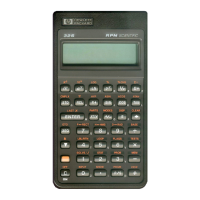T 0.0000
Z 0.0000
Y
0.0000
X
0.0000
"Oldest"
number
Displayed
The most 'recent* number is in the X-register: this is the
number
you
see in the
display.
In programming, the stack is used to perform calculations, to tempo
rarily store intermediate results, to pass stored data (variables) among
programs
and
subroutines, to accept input, and to deliver output.
The
X-Register
Is in
the
Display. The X-register is
what
you see
except
when a menu, a message, or a program line is being displayed.
Youmight have noticed that several functions' names include an x or
y. This is no coincidence: these letters refer to the X- and Y-registers.
For
example,
Hi
10*1
raises ten to the power of the number in the
X-
register (the displayed number).
Hi clear I
{x}
versus
[c]. Pressing Hi
clear
I {*}
always
clears the
X-register to zero,
and
it is also used to program this instruction. The
I"c1
key, in contrast, is context-sensitive. It either clears or cancels the
current display, depending on the situation: it acts like
Ml
clear
I
{x}
only when the
X-register
is displayed.* It
cancels
other displays:
menus, labeled numbers, messages, and program entry.
Reviewing
the
Stack
(|R+ I)
The IR+I
(roll
down)
key lets you review the entire contents of the
stack by 'rolling' the contents downward, one registerat a time.
You
can see each number when it enters the X-register.
*
@]
also
acts
like
111
CLEAR
I{*}
when
the
X-register
is
displayed
and
digit
entry
is
termi
nated (no cursor present).
36
2:
The
Automatic
Memory
Stack

